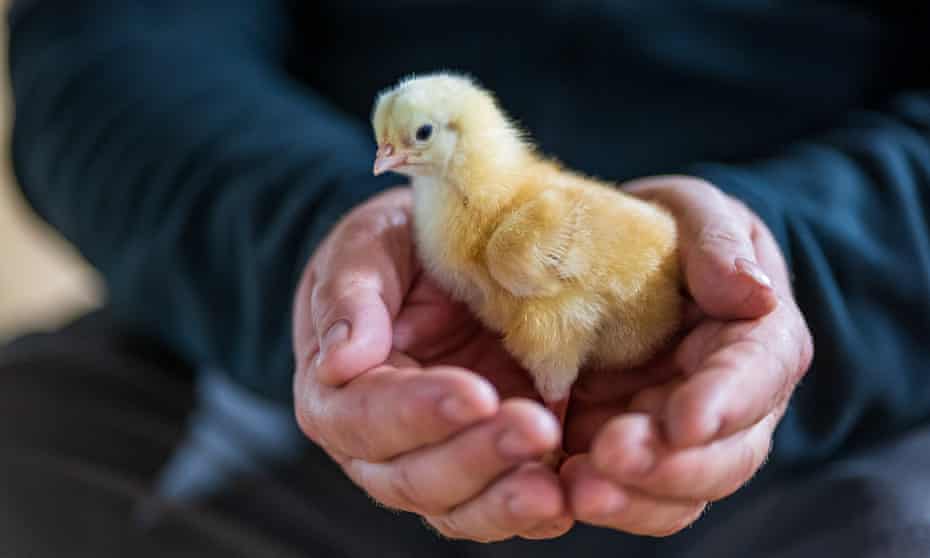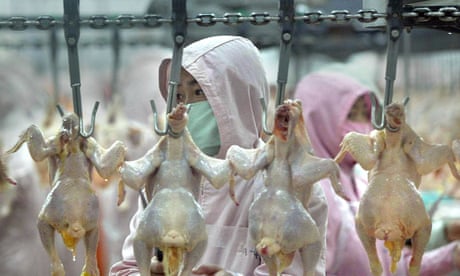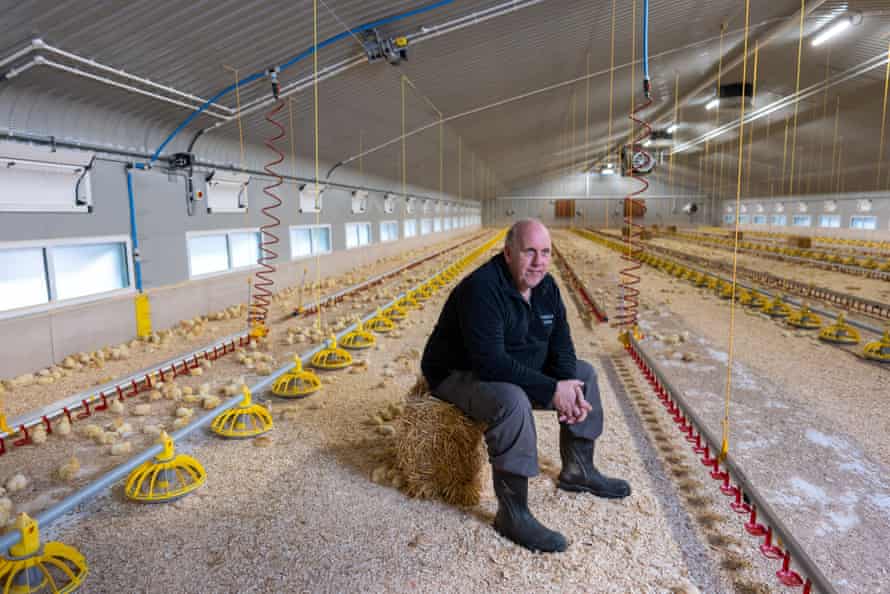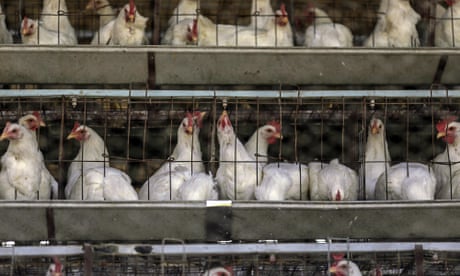Fifty years ago, a medium broiler cost the equivalent of £11 today. Now it is less than a latte or a pint of beer, raising serious ethical and environmental questions

Simon Usborne The Guardian Wed 24 Nov 2021 06.00 GMT
A giant metal shed in Somerset is alive with the chirps of more than 17,000 three-day-old chicks. The yellow balls of fluff are still adjusting to their new home. When one breaks into a run, dozens more follow. They move like leaves blown around a town square.
“They’re not all named!” says Simon Barton, raising his voice above the din. Chicks climb over our boots, pecking at everything in search of food. We shuffle rather than walk lest we squash one.
Barton, a former TV engineer, quit the BBC 25 years ago to move here with his wife, Karen, a nurse. The couple took over and grew Karen’s father’s chicken farm not far from the Quantock Hills. They now produce more than a million birds a year.
The chicks arrived two days ago in a lorry from a huge hatchery. In the next six or seven weeks, they will multiply in weight 45 times to reach their target of 2.4kg (5lb 5oz). The broilers, as meat chickens are known (“layers” lay eggs), will then be trucked to a poultry processor and on to customers including Sainsbury’s.
Right now Barton has 197,000 chicks across several sheds. The one I’m in is the length of a jumbo jet. It sounds like a lot of birds. It looks like a lot. Yet in the UK we eat 17,000 chickens – the number I’m looking at in this one shed – every nine minutes. We consume more than 1bn broilers a year.
Later, sitting in his modest home office, Barton looks at the Sainsbury’s prices for whole chickens like his. “So, they do a medium bird for £3.50,” he says, running a finger over a page in his diary, where he occasionally scribbles numbers from supermarket websites. He looks up at me. “That’s the price of a latte.”
Animal welfare organisations have long criticised a complex supply chain that has grown into a stunningly efficient beast of protein production. Advances in breeding and nutrition along with basic economies of scale have slashed prices. Now the industry itself is asking questions about the fraught chickenomics of the £3 broiler.
Last month, in an intervention that made headlines, Britain’s typically shy “chicken king” called for a “reset” on pricing. It was perhaps surprising because Ranjit Singh Boparan is arguably the chief architect of the industry. As the UK’s biggest poultry supplier, his 2 Sisters Food Group processes more than 10m birds a week, including all of Barton’s broilers.
“How can it be right that a whole chicken costs less than a pint of beer?” Boparan asked in a press release under the headline “Food’s great reset”. The effects of Brexit, the pandemic and soaring costs were “decaying the food sector’s supply-chain infrastructure”, he said, warning that shoppers face a “different world” in which they pay more.

Labour, heat, electricity, packaging and the carbon dioxide used in processing and packing are all more expensive. The price of chicken feed, which accounts for 70% of Barton’s costs, is up 15%. A poultry plant in Yorkshire last month reported that the three tonnes of offal it normally sells each week was going in the skip because there was no one to process it. The British Poultry Council tells me Brexit cost the sector 15% of its workforce.
Yet the cost of chicken in the meat aisle and on menus has so far remained pretty steady. At the time of writing, Tesco is selling a whole bird for £2.66, flagging it as an “Aldi price match”. Then there are all the processed products, from breast fillets to dippers and Tesco’s “meaty strips” for dogs, which contain “animal derivatives” including chicken.
We have come to expect our most popular protein to be affordable. Low-income shoppers depend on it. “But we’ve run out of headroom,” says Barton, pushing his hands together to illustrate a squeeze. With the help of big loans, he has invested £1.5m in the farm in the past five years – all of it to maximise efficiencies and cling to profitability. The new shed he’s showing me, which is heated to a constant 32C (90F), cost almost £500,000 to build. “Everything’s pretty much down to the last penny now,” he adds.
Barton, who is proud of what he does, is willing to show me what it takes – and costs – to grow affordable chicken. I want to know how we got here. What are the consequences for animal welfare and the environment, words that were notably absent from Boparan’s cri de coeur? And, if not £3, then what is a fair price for a chicken?

In 1967, when the government started recording average chicken prices in the UK, a kilo cost 39p. In September this year, a kilo cost £2.76. Adjusting for inflation, that’s actually a huge price drop; 39p in 1967 would be £7.24 today. A medium broiler 50 years ago was about £11 in today’s prices.
We can trace the decline to a small town in Maryland. In 1948, tens of thousands of fertilised eggs from across the US arrived at a farm for a competition to find the “chicken of tomorrow”. At the time, chickens were still reared primarily as egg layers. Male birds were a byproduct to be culled as chicks or reared as tasty but scrawny and barely profitable broilers.
After the deprivations of war, the industry spied an opportunity to feed the world with bigger, better, cheaper, faster-growing chickens. After 12 weeks, the competition birds were slaughtered, weighed and judged. The winning bloodlines were interbred in what was the start of a revolution. It turned chickens into a science project, a plump commodity – and a fast-food staple.
The UK played a big part in it. In 1956, a Scottish company called Chunky Chicks secured a licence for some of the genetic stock from the Maryland contest. Chunky Chicks was then acquired by the Ross Group, which is responsible for one of the world’s most popular broilers, the Ross 308. Meanwhile, in East Anglia, a US company called Cobb created the Cobb 500. The birds had lighter bones, bigger breasts, faster growth rates and smaller appetites for expensive feed.
Cobb and Ross are now owned by, respectively, the US-headquartered food conglomerates Tyson and Aviagen (Aviagen is in turn owned by the secretive German billionaire Erich Wesjohann). They engineer and breed branded chicks with varying characteristics, selling these into the global industry of breeders and hatcheries. Cobb 700s, for example, are advertised for their “outstanding breast meat yield”. Ultimately about 90% of the world’s broilers are now Cobb or Ross birds.
Chickens were well suited to this kind of forced evolution. “The generational gap is so fast, which means these two companies can change things really quickly,” says Emily Burton, a professor of sustainable food production at Nottingham Trent University and a poultry nutritionist. While their controversial use in the UK has declined, antibiotics were also vital in making giant sheds viable for huge flocks.
As the industry grew, attracting big players and buyouts at every level of the chain, there was no stopping a meat that met few cultural or religious barriers to consumption. “But when you position yourself as the lowest-price commodity product, the only way is down,” says Burton. “The margins are too tight.” To reverse the decline, she adds: “You really have to reinvent yourself.”
Until January this year, Liam Hodgson worked at Moy Park, a rival to 2 Sisters Food Group. In a poultry version of “poacher turned gamekeeper”, he then joined the RSPCA. As corporate outreach manager, he is now responsible for promoting chicken welfare. “A lot of the other charities were sceptical of me at first,” Hodgson, 28, tells me.The chicken run: blood, sweat and deceit at a UK poultry plantRead more
The RSPCA has for decades challenged a rapacious business model. It is increasingly now working with the industry to find the next “chicken of tomorrow”. Hodgson sees opportunity in Boparan’s call for a reset. A squeezed supply chain may be the chicken king’s primary concern, but an appetite for change may also benefit animals that have endured 75 years of unnatural selection.
The cheapest broilers can now reach slaughter weight in five weeks. Such gains in crowded sheds, where birds are denied the chance to peck, perch and explore, can strain hearts and legs, and harden muscle. Chicken faeces can cause lesions and ammoniaburns on feet and legs. In the Netherlands, animal welfare groups call five-week broilers plofkip, which roughly translates as “exploded chicken”.
Abattoirs can be ugly too. Exposure of bad practice, as well as high-profile welfare campaigns, have helped lift standards. But minimum requirements are still not exactly plush. Sheds in the UK can house no more than 39kg of bird a square metre. By the time they’re ready for processing, that’s the equivalent of about 16 fat chickens on a beach towel.
In Somerset, Barton is at the forefront of a shift towards higher standards. He owns another farm, not far from the one he’s showing me, where chicks are stocked at a marginally roomier 38kg/m2, which meets standards for the Red Tractor assurance scheme. Red Tractor chickens must also have windows, and bales and logs for perching and pecking.
The chicks I’m meeting are RSPCA Assured broilers. They are stocked at 30kg/m2 and are a different breed – Hubbard JA87 – that grow for a couple more weeks (Hubbard, a multinational hatchery, is part of Aviagen). They have more to peck at and perch on, although they are still reared indoors. Assured birds also meet the Better Chicken Commitment (BCC), a welfare policy launched with RSPCA backing in 2017. It challenges retailers and food companies to switch all supplies to the higher standard by 2026. Waitrose and KFC signed up in 2019. M&S announced this year that it would meet the standard by 2022. But hundreds of other big companies are lagging.
Switching requires investment. But after that, Barton tells me returns for BCC and Red Tractor birds are roughly the same, because he can charge 2 Sisters about 20p more a kilo for the higher standard. He says Red Tractor birds still make up about 95% of the market, but he and Hodgson expect that to change as the industry looks for wriggle room in which to “reset” prices – and expectation of price – and consumers demand better welfare. But this will have unintended consequences.
Poultry production is so efficient that, kilo for kilo, it has a relatively low carbon impact – roughly on a par with olive oil and almost a 10th of that of beef, according to the Carbon Brief website. But higher welfare standards require more land, more heat and more feed, which mostly comes from land-intensive soya. If we want to eat “happier” chickens, there will be an environmental cost.
Of course, we could eat fewer animals. The next “chicken of tomorrow” may yet be grown in a laboratory. The rise of flexitarianism may also help. In the meantime, while BCC may not look like a welfare revolution, the RSPCA sees it as an achievable compromise. “It’s not perfect, but it’s a positive step in the right direction,” Hodgson says. Burton, who has independently researched the sector for almost 25 years, is more effusive. “BCC is the most exciting thing that has happened in the industry since I started,” she says.
Barton’s RSPCA Assured chicks are still getting used to their shed. Suspended lines dispense feed granules into plastic yellow pans. Two shiny steel weighing platforms also hang from the ceiling for curious chicks to hop on as they please. Barton can see via an app on his phone that today each bird weighs 67g – a 14g gain in two days. “It ramps up later,” he says.
A recent RSPCA survey, which did not include prices, suggests that 85% of 18- to 34-year-olds are willing to pay more for slower-growing chicken – and 70% in older age groups. Barton says an industry of entrepreneurs is poised to adapt – to reset. He thinks 2 Sisters may soon ask him to convert all his sheds to BCC standard to meet rising demand. Apart from anything, he adds, farmers prefer more spacious sheds “because there’s more room to walk through the birds”.

I ask the farmer what he thinks is a fair price for a chicken. Like everyone I speak to, he prefers not to put a figure on it. “We just want a proportion of any increase,” he says. Hodgson estimates BCC birds are 20-30% more expensive for consumers – another pound on our £3.50 Sainsbury’s medium whole chicken. If more than your average latte, £4.50 is still in pint-of-beer territory, to use Boparan’s comparison.
Of course, you can pay a lot more. A free-range or organic chicken, which is even slower growing and has spent plenty of time outside, costs from £11 in supermarkets. That’s a striking match of the 1967 average.
Barton is just about still making a profit, but knows of other farmers on the brink. Everyone fears the effects of a strain of avian flu now sweeping the country. “It’s becoming very tense,” Barton says. Ultimately, he tells me, it won’t be he who determines the value of our favourite meat – but me and you. “At the end of the day, we will produce what the consumer wants,” he says before we shuffle carefully out of the shed and lock the door.
